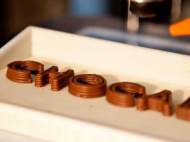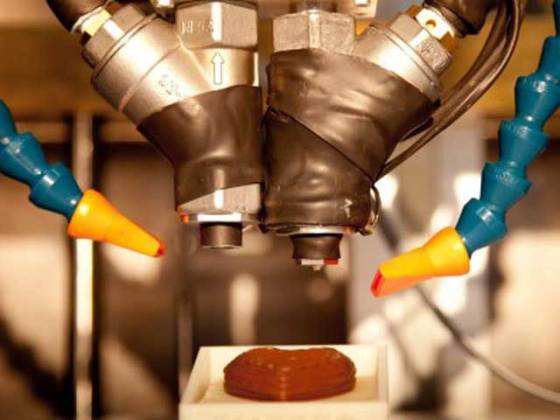3D chocolate printer lets you get creative with chocolate
 A while ago we wrote about Cornucopia – a printer for food, which works by storing, precisely mixing, depositing and cooking layers of ingredients. A group of researchers came up with their twist on food printing technology and made a 3D chocolate printer. In the long term, the technology could be used by customers to design many different custom-made products themselves.
A while ago we wrote about Cornucopia – a printer for food, which works by storing, precisely mixing, depositing and cooking layers of ingredients. A group of researchers came up with their twist on food printing technology and made a 3D chocolate printer. In the long term, the technology could be used by customers to design many different custom-made products themselves.
The development of 3D chocolate printer has presented many challenges, since chocolate requires accurate heating and cooling cycles. These variables then have to be integrated with the correct flow rates for the 3D printing process. Researchers from the University of Exeter collaborated with the Brunel University to overcome these difficulties with the development of new temperature and heating control systems. Unlike other printing processes which remove the excess of the material to create a desired object, the 3D chocolate printer relies on depositing successive layers of chocolate.
“What makes this technology special is that users will be able to design and make their own products. In the long term it could be developed to help consumers custom-design many products from different materials but we’ve started with chocolate as it is readily available, low cost and non-hazardous”, said lead researcher Dr Liang Hao, from the University of Exeter’s College of Engineering, Mathematics and Physical Sciences. “There is also no wastage as any unused or spoiled material can be eaten, of course! From reproducing the shape of a child’s favorite toy to a friend’s face, the possibilities are endless and only limited by our creativity.”
A consumer-friendly interface to design the chocolate objects is also in development by Delcam. Researchers hope that an online retail business will host a website for users to upload their chocolate designs for 3D printing and delivery. The web-based utility will allow users to see designs created by others to modify for their own use.
“In future this kind of technology will allow people to produce and design many other products such as jewelry or household goods. Eventually we may see many mass produced products replaced by unique designs created by the customer”, said Hao.
The researchers didn’t mention when would this technology become available for online usage, but if it proves to be affordable it could become very popular since you wouldn’t have to purchase the whole machine to surprise that special someone with a custom-designed chocolate delight.










Dr Hao founded the Choc Edge company to commercialize the device after interest from retailers. He hopes that an commercially available machine will be deployed by end of April – just missing the Easter egg rush.
“We’ve improved and simplified the machine, so now it is really easy to use”, Dr Hao said for BBC. “You just need to melt some chocolate, fill a syringe that is stored in the printer, and get creative printing your chocolate.”
This device here will be more affordable for every obese American family to own. You can print all of the 3D chocolates you and your obese children can eat. Before the average overweight person tried to stay away from the chocolate stores, now they have to stay away from the chocolate machine that sits on the counter in their kitchen.
United States of OBESE America